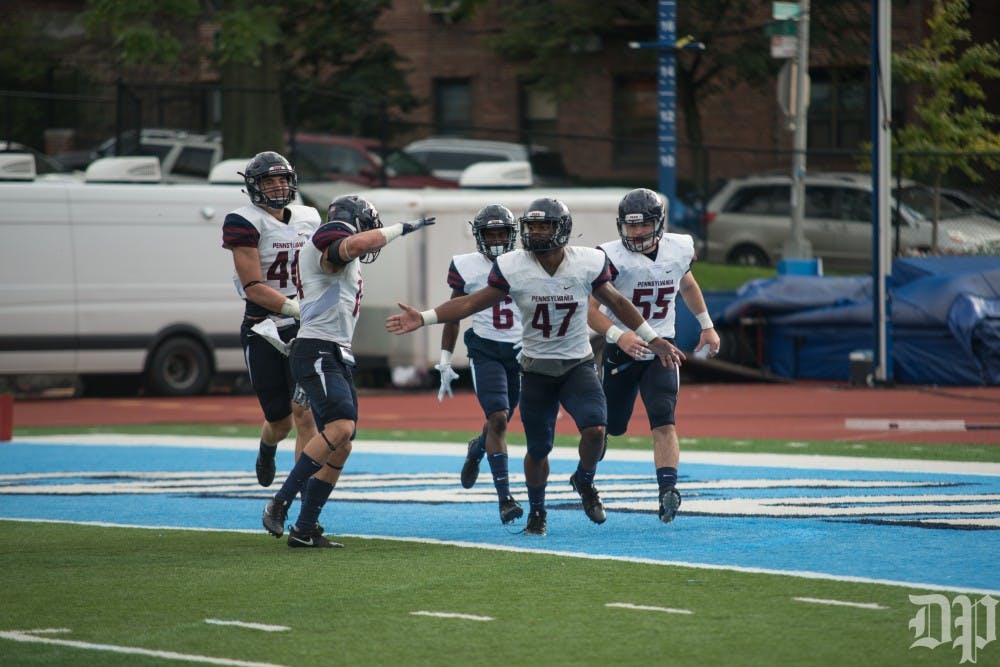Every game that Penn football won against NCAA Division I opponents this season had something in common: they all featured at least one crucial stop in the red zone.
The Quakers had high expectations coming into this season, following a pair of back-to-back Ivy League Championships. Penn received five first-place votes in the league’s preseason media poll and was ranked just behind Princeton and Harvard, despite losing last year’s strong group of seniors, including star quarterback Alex Torgersen.
Despite the team's winning record and a stunning, last-second victory over rival Princeton, most Penn fans were disappointed by this year’s results, especially given that the Quakers may have actually been the best Ivy team this year.
Penn’s heartbreaking losses featured a comeback and overtime loss to Columbia and a narrow victory by Dartmouth on the last play of the game. Beyond the drama of these games, however, is an important fact: Penn’s games were incredibly close this season.
This doesn’t just apply to its losses, either. Penn’s average margin of victory or loss was the lowest among the Ivy League and was nearly a touchdown below the conference average.

So what’s the point?
When all the games are close, and a win or loss is decided by a single score, how a team plays under pressure becomes extremely important. When teams are fairly evenly-matched, they need to come up with big plays when it counts.
They need to get stops in the red zone — that is, in the 20 yards in front of their own end zone.
Every football team has challenges, and Penn did a lot of things well this season. Its rushing attack was the second best in the conference. Its kicking was incredibly consistent. The Quakers were even the most disciplined team, giving up the fewest yards to penalties in conference games. However, they had one glaring weakness — the league’s worst red zone defense.
In every game that Penn lost opponents this year, they failed to get a single stop in the red zone. In every game they won, they got at least one stop. Games were won and lost for the Quakers with their backs up against the goal line, and their disappointing season stems from the fact that far too often, they couldn’t come up with a stop.
The problem wasn’t their defense overall, which ranks around the middle of the pack in most metrics. They were right around average in how often they let opponents get to the red zone, too.
Where they fell well below average was in red zone defense. At nearly 86 percent, the Quakers gave up more scores per chance in the red zone than any other team in the conference. However, this doesn’t tell the full story, as there are myriad factors left unaccounted for in this metric.
As most football fans know, it’s actually a big accomplishment for a defense to stop a touchdown and force a field goal attempt — but a successful field goal still counts as a red zone score. On the other hand, a missed field goal is given the same weight as an interception, despite the fact that an interception is a huge defensive success while a missed field goal (except for blocked kicks, which are rare) often has nothing to do with the defense.
It’s far better to look at the defense in terms of the points they allow on average. The Ivy League doesn’t compute that metric, but the model below can be used to represent this. For each chance an opponent has in the red zone, it provides the average points one would expect them to score. This is based on all their DI games this year (excluding the team’s win over DII Ohio Dominican, because no other team in the conference played a DII team) and based on all their Ivy games this year.

The results are pretty definitive: Penn gives up a lot of points in the red zone. The Quakers aren’t last only when non-conference games are excluded. A possible explanation is that this is because Penn scored many times in the red zone on both the Tigers and the Crimson, and so with a smaller sample size of seven games, that pushes Princeton's and Harvard's expected points allowed (EPA) higher.
In either set of data, Penn is between one and one and a half points behind Yale, the red zone defensive leader and 2017 Ivy League Champion. This is well under a made field goal in value, so it might not seem like that big of a deal.
However, even a small difference can matter when game margins are small and the offense has multiple opportunities in the red zone.
As a result, a shift from an EPA of 5.44 to 3.93 would be enough to flip every Ivy League loss this season, although the team would still have lost to Central Connecticut. On average, the Quakers would be 9-1, Ivy League Champions, and undefeated in conference play.
This reinforces what was already clear from looking at Penn’s margin of victory/loss: when games are close, these critical moments make all the difference.
Although the team is surely disappointed by this season’s result, these statistics are a reason to be hopeful. Although many strong members of the team will be graduating this spring, including star wide receiver Justin Watson, who is a finalist for Ivy League Player of the Year, there is little reason to believe that the team won’t have games just as closely-fought next season.
Just like this season, the Quakers should be among the best in the conference and a contention for their third championship in four seasons.



